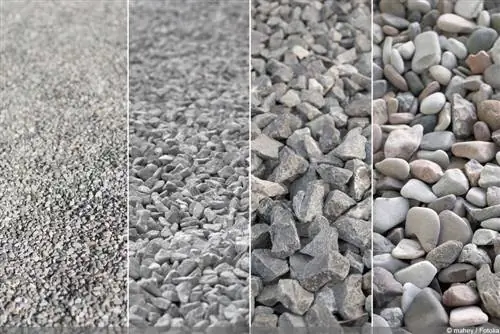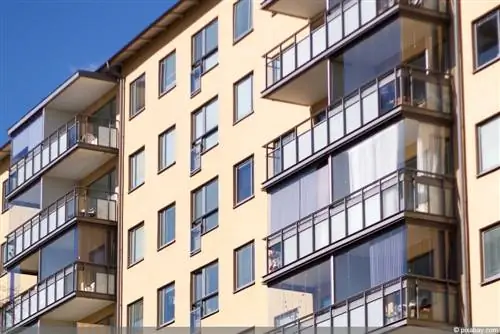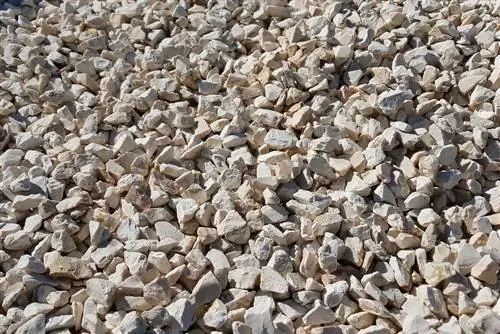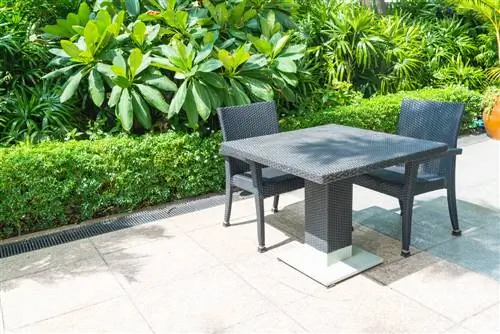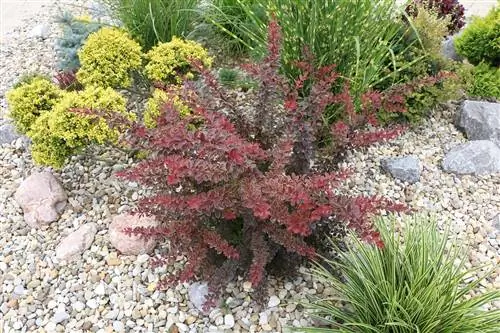- Author admin [email protected].
- Public 2023-12-17 03:39.
- Last modified 2025-01-24 12:45.
When laying gravel, a few things should be taken into account so that the area remains nice to look at and you don't end up having to do more work with it. It is always a good idea, for example, to surround all areas covered with gravel. This is particularly important if there are lawns in the immediate vicinity. Gravel on the lawn is annoying. A border ensures that the gravel stays in the bed where you want it.
Advantage of gravel in the garden
If you want to avoid weeds, you should lay out a garden and weed fleece under the gravel. You shouldn't be stingy with these fleeces and should rather use the better ones from the specialist store. There are some really cheap ones in discount stores, but you won't be able to enjoy them for long. The higher investment is worth it here. If you spread a really thick layer of gravel, i.e. more than 7 or 8 cm, you can leave out the fleece, because then the gravel alone ensures that weeds have no chance, at least as long as no humus has accumulated on and between the upper stones. Then even a weed fleece is no longer of any use.
Tip:
We read and hear again and again that cats use gravel surfaces as toilets and also like to dig there and “dig up” everything. This is often reported, especially with very fine gravel. The only thing that helps here is to lay a PVC grid and spread the gravel over it. Of course, it gets complicated with plants in the area, so you have to come up with something. Lawn paving stones work in a similar way.
How much gravel per square meter?
Many companies that offer Kies on the Internet have installed a demand calculator on their sites. There you can enter your dimensions, how thick the layer should be and at the end you get the amount that is required. You should leave some room for maneuver, so don't order too little, because the stones will compact over time and then you can fill them up again.
www.hornbach.de/cms/de/de/projekte/hofeinfahrt_machen/wege_mauern_anlegen/kiesrechner/kiesrechner.html
You should keep in mind that the different types of gravel have different weights. So if you find somewhere that someone has used so much gravel for one square meter, you can only relate this to their area if they use the same gravel.
- Formula: desired area in m² 0.05=required gravel in cubic meters
- An approximate guideline: gravel has a density of 1.8 t/m². For a 10 cm thick layer you need around 180 kg/m²
Laying ornamental gravel
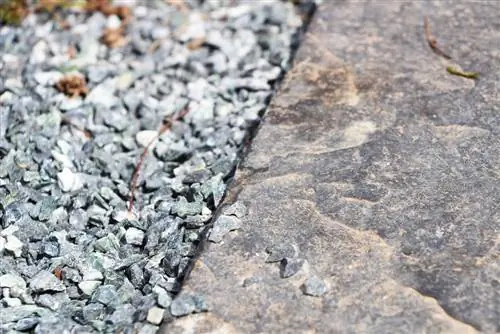
Laying ornamental gravel is not difficult. The soil must be well prepared so that no weeds can fight their way through from below, otherwise it's quite easy. The most difficult thing is often deciding on a type of gravel. The range is large and you can always find an interesting species that you like. It's best to get advice from an expert about the advantages and disadvantages of the varieties.
- First the ground must be prepared. Plants that are in the desired area must be removed. Larger shrubs or trees can of course be left standing, but lawns, ground cover and similar plants are better off planting out. If you pile up the decorative gravel around them, they will be too deep. Many plants don't get that.
- The soil of the desired area should be dug, a good 5 cm deep. It's good when everything is level. If there is a slope, it should rise or fall evenly.
- Cover the floor completely with weed fleece. Pegs can be used to fix these in place.
- If there are plants on the area, the fleece must be cut in a cross shape. The corners must be placed close to the plant, otherwise weeds will grow out of the ground around the plant.
- The gravel can then be spread over the area.
Plants for gravel areas
Topiary trees are often planted. They look good, especially if you buy them a little larger. What is usually forgotten is that they need care and not too little. They are actually not intended for dry areas. There are better plants that require little care and hardly any water, e.g. B. Feather grass and switchgrass. They bring elegance to the facility. In spring, flower bulbs are ideal, but the wild species. They have the advantage that they become more and more beautiful over the years, unlike the highly cultivated varieties, which often only bloom for one more year. Otherwise, yarrow, purple garlic, oxtongue, prairie beard grass, chamomile, silvery garden wormwood, Junker lily, affodil, beard flower, spur flower, feather carnation, ivory thistle, palm lily man litter, golden spurge, magnificent candle, cushion gypsophila and many others are suitable more.
Conclusion
Laying ornamental gravel is not difficult. Today when you go for a walk you will find many gardens that are completely landscaped with ornamental gravel. There is no lawn anymore, everything is “paved over”. The areas often appear cold and bare, with only one or two topiary trees standing out. Apart from the appearance, what about the microclimate if everyone around them creates their gardens like this? Where are insects, birds, all the other little animals? Paving and closing the whole garden just because it doesn't take much work? For the money you spend to create the garden like this, you can buy a lot of plants and plant them so densely that they cover the ground so that weeds can no longer grow. Not only does it look more natural, it is also significantly better for us humans, the animals and the environment. Covering individual areas with gravel is fine, but not the entire garden, please!

